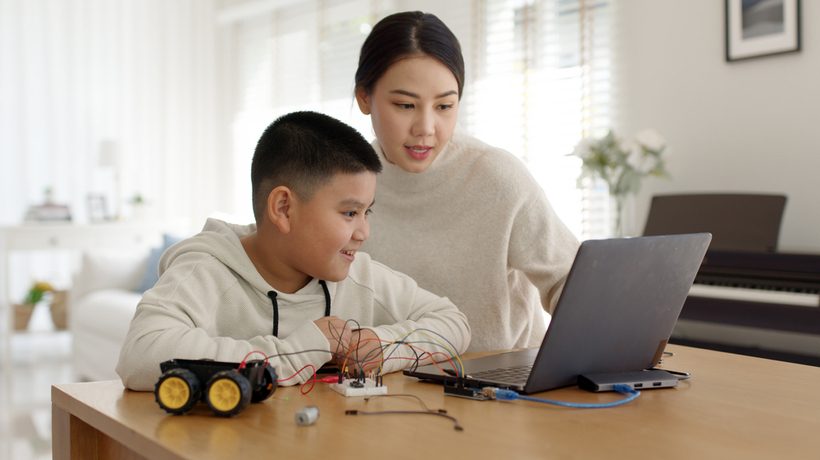An Online Course Isn't A Product But An Experience
An online course is not a product; it's an experience. Courses shouldn’t be made "to sell" but rather to take your students on a journey that helps them meet their goals. A course is only as good as its ability to serve its audience, providing knowledge or skill training. Creating a course from a learner experience design perspective is all about the learner and learning process, and less about teaching resources, course management, and marketing methods.
As you create an online course, you should be on the lookout for the best strategies to help your students learn and engage. This is especially important in online education, where captivating students is particularly challenging. In this article, we’ll explore some of those strategies as well as look into what learner experience design entails, why it matters, and how to implement its principles in your online courses.
What Is Learner Experience Design?
"How can I use content, activities, and technology to facilitate the learning and application of knowledge and skills?" This is the question that all online course learner experience designers seek to answer.
Humans learn from experience, but not all experiences provide us with the same amount or quality of knowledge. Likewise, all courses intend to teach, but only a few accomplish their goal. Learner experience is measured by how effective your course is at helping your students reach the desired outcome.
Hence, the importance of learner experience design, which refers to the process of creating a learner experience that helps students learn, achieve, and benefit the most out of their learning journey.
Essentially, learner experience design involves any actions taken to improve the process or user flow students go through when completing a course with the purpose of:
- Enhancing and promoting learning
- Boosting student satisfaction
- Maximizing results in skill and knowledge acquisition
Online Courses And Their Learner Experience Design Challenges
Online education continues to rise in popularity, with more and more courses available online. However, many educators fail to adapt their content to its new environment, resulting in disappointing learning experiences.
Most of the courses offered online are made up of the same basic, yet boring, structure: a series of short video recordings or text snippets, some downloadable files, and, at best, a discussion forum. Lecturing to the class, holding some discussions, and completing mandatory reading might work well in a real-life classroom, but it doesn't translate into an engaging experience in an online setting.
At a distance, keeping a student-focused, engaged, and interested is far more challenging. It is only through a creative and science-based approach that online educators will captivate the learner and boost course completion rates.
How Can You Improve Learner Experience In Your Online Course?
Improving the learning experience begins with understanding the learner. A good way to gain a better understanding of your students and their needs is to answer the following questions:
- What does your student want to accomplish or learn?
- What is the student’s level in regard to previous knowledge, abilities, and behaviors?
- What does the student need to be able to know, do, or change after completing the course?
- What tools does the student need to reach their goals?
- What metrics will be used to measure your course’s impact and students’ success?
With a better understanding of your students, you can take on the process of constructing a valuable learning experience that is both pleasant to take part in and helps them reach their desired outcomes.
With this mindset in mind, here are the areas you need to focus on to design a positive and effective learner experience:
1. Content
Creating content is commonly the first task educators approach when preparing to launch an online course. Ultimately, the product on sale is your course’s content. Its quality will directly impact learner experience, student satisfaction, and course sales.
Here are a few things you can do to improve your course content, and, in turn, improve your student’s learner experience:
- Establish clear learning objectives: There’s no point in enrolling in an online course or any other learning journey if it doesn’t help you reach your goals. Before creating any content, you must precisely define your course’s learning objectives. With this in mind, you can tailor lessons, topics, activities, and evaluations to help your students reach these goals. At the same time, defining learning objectives will help you define the functional requirements and features that will best host your course and serve your students.
- Diversify content types: Monotonous content is a sure way to bore your learners. Diversifying your courses, with a good balance of video, text, images, and interactive content, will keep your students’ interest high and increase course completion.
- Relate content to real-life scenarios: All learning should be able to be applied in real-life situations. Relating your lessons around specific, real-life applications helps your students absorb knowledge in a practical way, enhancing their learning outcomes. You can easily implement this strategy by opening up each lesson with a real-life case study, problem, or task. After exposing your students to a practical scenario, you can then share related concepts and content with a more focused perspective.
- Make content appealing: It’s a fact that humans respond better to human interaction than to other forms of communication. According to research featuring videos with real humans, live sessions, and using human avatars throughout your learning content will promote learning among your online students. Applying basic design concepts, easy-to-read fonts, and eye-catching colors will also help keep your students’ attention on the screen.
2. Structure
We must stop thinking about our online courses as separate lessons and topics and look at them as complete "experiences." All parts of the course should connect with one another and be organized in a way that is both easiest to digest and the most useful.
To improve learner experience, we recommend presenting content with a logical and useful progression. For example, when a baby is learning to walk, mothers first help them master standing on their own. Only after mastering balance, toddlers are able to take a few assisted steps and eventually walk on their own. Approaching the process in any other order would be overly complicated and ultimately inefficient.
Applying the same type of logic to your online course design will help you create the most efficient structure for your online course. You can get started by examining your course’s main learning objectives and breaking them down into smaller topics and concepts. Figure out how different parts of your course relate to each other, considering difficulty level, order of occurrence, and possible applications. Then, you can create a curriculum, where your students can build up their knowledge and skills progressively.
Pro tip: Include assignments or evaluations throughout to help you determine whether your students are actually getting closer to their objectives as they move through the course.
3. Function
When improving the learner experience, course creators need to take into account not only content but content delivery methods.
In a real-life classroom, course delivery methods include physical classroom facilities, teachers, textbooks, lab materials, a whiteboard or projector, scheduled office hours, etc.
Likewise, online courses depend on the functional elements that enable the efficient delivery of educational content. In eLearning sites, functional requirements are met by an LMS, web design, content, user management features, and support. The more function and content they can integrate, the more streamlined your students' learning experience will be.
It is important that your platform's functionality can properly help you meet learning objectives by enabling you to offer the ideal type of learning activities. For example, if you need your students to collaborate, having a platform that offers features such as discussion boards and group chat is essential.
Here are some functional improvements to consider in your learning management system, that will help you improve learner experience:
- Prioritize user-friendliness: Accessibility is a vital concern in online education. Your students should be able to easily access and navigate through the courses they enroll in, with as little fuss as possible. Good UX design, logical course progression, and good organization can do wonders for delivering a better user experience.
- Use technology that favors learning goals: An effective learning experience implements tools and resources that cater to different types of learning activities and best adapt to learning objectives. For example, a music teacher can benefit more from video or audio submissions from students to evaluate progress, while a science teacher can use quizzes and questionnaires to gauge results.
- Implement engagement boosting strategies: Beyond acting as a tool for presenting your content, online learning management systems can help you connect and engage with your student community. For example, implementing a gamification strategy is a great way to boost engagement in your online courses. You can do this by rewarding your students with badges when they complete a lesson or pass a quiz. You can also award points, create a ranking system, or even create a sense of competition with leaderboards.
- Eliminate communication barriers: In a real-life classroom, communication between the student and instructor, as between peers, plays an important role. When delivering online courses, finding efficient communication channels can be more challenging. However, with a good LMS and website development, you can propitiate better communication. Some features to include are forums, discussion boards, live chat, webinars, student partners/groups, and one-on-one live tutoring sessions.
- Personalize learning paths: Adapting courses to each learner allows each student to personally connect and benefit from their learning experience. If you have a diverse pool of students, you can evaluate their initial knowledge and skills in order to enroll them in the most beneficial course for them. You can also create specialized learning paths taking students through multiple steps to reach a specific goal.
4. Measuring Results
In online learning, evaluating progress and measuring results is just as important as delivering content. Evaluating your students throughout the course is vital to figure out if your students are actually learning.
Some tools that’ll help you evaluate your students' progress include:
- Quizzes and tests
- Projects and assignments
- Essays
- Live Q&As
5. Collecting Feedback
Finally, once your students go through your course, it is important to give them an opportunity to provide feedback about their learning experience. Student reviews will help you determine where your course succeeds and identify specific areas of improvement. Since a good learning experience focuses on serving the needs of the learner, there is no better way to determine how you can improve your learners' experience than communicating with the learners themselves.
The Importance Of Learner Experience Design
"Learning is something people do. Training is something you do to people" - Jay Cross
As an online course creator, true success is found when your course helps students achieve something in an efficient and enjoyable way. Well-applied LX design can make a significant difference in terms of course completion rates, student satisfaction, and course sales. Plus, your happy students will be more likely to talk about your course and share positive reviews.









